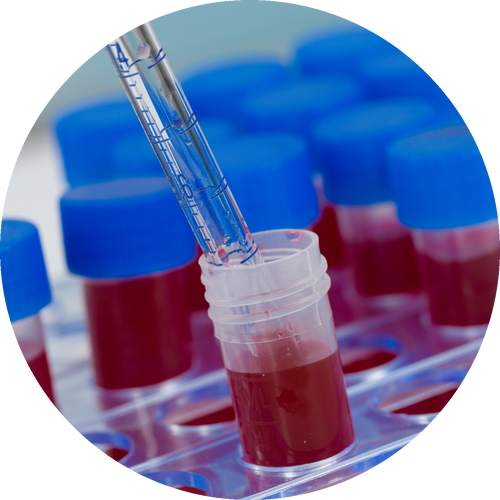
OptiPrep™ (iodixanol solution)
Nycodenz® iohexol powder)
Lymphoprep™
Lymphoprep Tube™
Polymorphprep™
Polysucrose™ 400
Polymorphprep™-related Documents
Polymorphprep Package Insert
Application Overviews
Analysis of Membrane Trafficking
Isolation of Blood Cells
Isolation of Cells
Isolation of Exosomes
Isolation of Macromolecules and Lipoproteins
Isolation of Plasma Membranes
Isolation of Cell Organelles
Isolation of Viruses
Fantastic Resource
Browse +100 Application Data Sheets and Citation Lists for Cells, Subcellular Components, Macromolecules, and Viruses

Polymorphprep™ is a ready-made, sterile, endotoxin-tested, separation medium optimized for human granulocyte (polymorphonuclear leukocyte, PMN) isolation. Following centrifugation of whole undiluted human blood samples through Polymorphprep™, PMNs accumulate in a distinct band above pelleted erythrocytes and below mononuclear cells retained at the sample/medium interface.
Physical-chemical characteristics
- Density 1.113 ± 0.001 g/ml
- Osmolality 445 ± 15 mOsm
- Endotoxin level < 1.0 EU/ml
- Sodium Diatrizoate 13.8 % (w/v)
- Dextran 500 8.0 % (w/v)
About Polymorphprep™
In principle, the greater buoyant density (>1.085 µg/ml) of PMNs (with the exception of basophils) can be exploited for their isolation from lighter mononuclear cells (< 1.077 g/ml). However, the high buoyant density of erythrocytes (1.09-1.11 µg/ml) complicates separation from whole blood using density gradient media like that used for mononuclear cells. However, the high osmolality of Polymorphprep™ causes erythrocytes to lose water and shrink, increasing their effective buoyant density, allowing dextran-aggregated erythrocytes to sediment rapidly through the dense medium. Because the osmotic gradient between the medium and erythrocytes declines as cells sediment further into the medium (i.e., water loss from erythrocytes is greatest at the top of the gradient and decreases progressively with sedimentation) – a diatrizoate gradient forms within the density cushion. Within this gradient, PMNs accumulate in a distinct band below mononuclear cells which are retained at the sample/medium interface. The method is effective only from whole undiluted blood, not from a leukocyte-rich fraction.
Temperature impacts the density and viscosity of Polymorphprep™ solutions. Thus, the temperature of blood samples and media should be kept between 18-22°C. Shown in the figure below is a Coulter STKR Cell Analyzer analysis of the top and bottom bands from a Polymorphprep™ separation, presented as the relative number of cells (ordinate) as a function of cell volume (abscissa). Relative cell number is the number of cells expressed as a fraction of the total in each sample. The top band contains only lymphocytes (40-80 femtoliters) and monocytes (80-130 femtoliters). All PMNs (150-320 femtoliters) accumulate in the bottom band with contamination from mononuclear cells being negligible and from erythrocytes between 2-6% of total cell number.
*10/25/2021
We would like to inform you about the changed specification of osmolality in Polymorphprep. The new specification for osmolality in Polymorphprep is now 440-500 mOsmol/kg (earlier 445+/-15 mOsmol/kg). All produced batches from 2021 will be affected by the change. The new specification will not have any effect on the separation. The main advantage of an increased osmolality is a theoretically more effective separation of the red blood cells from the other blood components. We can assure that all the other parameters remain unaffected from this adaptation.
| Documents & Links for Polymorphprep | |
| Application Note | Polymorphprep Application Note |
| Application Note | Polymorphprep Isolation of Human Polymorphonuclear Cells |
| MSDS | Polymorphprep MSDS |
| Flyer | Polymorphprep Leaflet |
| Documents & Links for Polymorphprep | |
| Application Note | Polymorphprep Application Note |
| Application Note | Polymorphprep Isolation of Human Polymorphonuclear Cells |
| MSDS | Polymorphprep MSDS |
| Flyer | Polymorphprep Leaflet |
| Citations for Polymorphprep – 5 Found |
| Weber, Evan W; Han, Fei; Tauseef, Mohammad; Birnbaumer, Lutz; Mehta, Dolly; Muller, William A. TRPC6 is the endothelial calcium channel that regulates leukocyte transendothelial migration during the inflammatory response. The Journal Of Experimental Medicine. 2015;212(11):1883-99. PubMed |
| Lakbakbi, Souad; Debrumetz, Alexandre; Rieu, Philippe; Nguyen, Philippe. Human Neutrophils Support Thrombin Generation in Peritonitis. Peritoneal Dialysis International : Journal Of The International Society For Peritoneal Dialysis. 2015;35(5):599-602. PubMed |
| Lachowicz-Scroggins, Marrah E; Dunican, Eleanor M; Charbit, Annabelle R; Raymond, Wilfred; Looney, Mark R; Peters, Michael C; Gordon, Erin D; Woodruff, Prescott G; Lefrançais, Emma; Phillips, Brenda R; Mauger, David T; Comhair, Suzy A; Erzurum, Serpil C; Johansson, Mats W; Jarjour, Nizar N; Coverstone, Andrea M; Castro, Mario; Hastie, Annette T; Bleecker, Eugene R; Fajt, Merritt L; Wenzel, Sally E; Israel, Elliot; Levy, Bruce D; Fahy, John V. Extracellular DNA, Neutrophil Extracellular Traps, and Inflammasome Activation in Severe Asthma. American Journal Of Respiratory And Critical Care Medicine. 2019;199(9):1076-1085. PubMed |
| Wodicka, James R; Morikis, Vasilios A; Dehghani, Tima; Simon, Scott I; Panitch, Alyssa. Selectin-Targeting Peptide-Glycosaminoglycan Conjugates Modulate Neutrophil-Endothelial Interactions. Cellular And Molecular Bioengineering. 12(1):121-130. PubMed |
| Barbu, Emilia A; Mendelsohn, Laurel; Samsel, Leigh; Thein, Swee Lay. Pro-inflammatory cytokines associate with NETosis during sickle cell vaso-occlusive crises. Cytokine. 2020;127:154933. PubMed |









